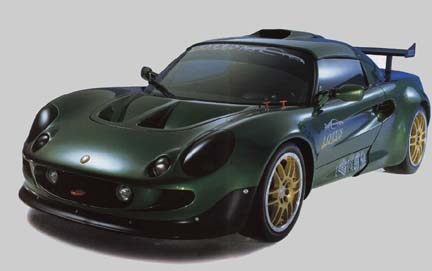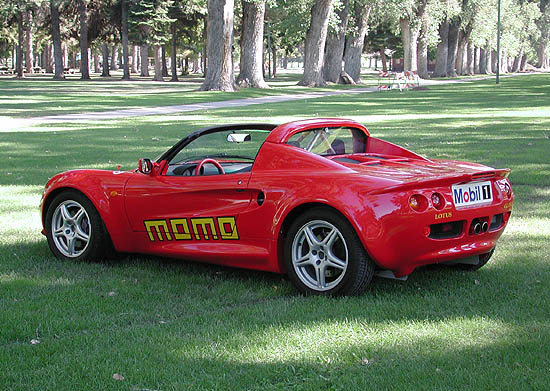The company was formed as Lotus Engineering Ltd. by engineer Colin Chapman, a graduate of University College, London, in 1952. The first factory was in old stables behind the Railway Hotel in Hornsey, North London. Team Lotus, which was split off from Lotus Engineering in 1954, was active and competitive in Formula One racing from 1958 to 1994. The Lotus Group of Companies was formed in 1959. This was made up of Lotus Cars Limited and Lotus Components Limited, which focused on road cars and customer competition car production, respectively. Lotus Components Limited became Lotus Racing Limited in 1971 but the newly renamed entity ceased operation in the same year.

1999 Lotus Elise 111S RHD

1999 Lotus Elise 111S
The company moved to a purpose built factory at Cheshunt in 1959 and since 1966 the company has occupied a modern factory and road test facility at Hethel, near Wymondham. This site is the former RAF Hethel base and the test track uses sections of the old runway.

A vendre 1999 Lotus Elise S1
By 1982 the company was experiencing severe financial difficulties and Chapman sought additional capital from outside sources. The crisis resulted principally from the fact that only a handful of Lotus cars were sold each year in the world's largest market, the US. These problems were solved by a young law professor and investment banking consultant, Joe Bianco, who was able to capitalize a new and separate United States sales company for Lotus. By creating an unprecedented tax-incentived mechanism (wherein each investor received a specially-personalized Lotus Turbo Esprit) the new American company, Lotus Performance Cars Inc. (LPCI,) was able to provide fresh capital to the British manufacturer. Former Ferrari North America general manager John Spiech was brought in to run LPCI, which imported the remarkable Giugiaro-designed Turbo Esprit for the first time. US sales quickly jumped into triple digits annually. This transaction was generally regarded as having saved Lotus from bankruptcy. LPCI was subsequently sold along with Group Lotus PLC to General Motors.

1999 Lotus Elise Engine
Chapman died of a heart attack in 1982 at the age of 54, having begun life an innkeeper's son and ended a multi-millionaire industrialist in post-war Britain. The car maker built tens of thousands of successful racing and road cars and won the Formula One World Championship seven times. At the time of his death he was linked with the DeLorean scandal over the use of government subsidies for the production of the DeLorean DMC-12 for which Lotus had designed the chassis.

[thumbnail of 1999 Lotus Elise

racing Lotus Elise Exige
In 1986, the company was bought by General Motors. On 27 August 1993, GM sold the company, for £30 million, to A.C.B.N. Holdings S.A. of Luxembourg, a company controlled by Italian businessman Romano Artioli, who also owned Bugatti Automobili SpA. In 1996, a majority share in Lotus was sold to Perusahaan Otomobil Nasional Bhd (Proton), a Malaysian car company listed on the Kuala Lumpur Stock Exchange.

1999 Lotus Elise Rear Right

Lotus Elise 111 (2000) 3/4

Lotus Elise
The company also acts as an engineering consultancy, providing engineering development—particularly of suspension—for other car manufacturers. The lesser known Powertrain department is responsible for the design and development of the 4-cylinder Ecotec engine found in many of GM's Vauxhall, Opel, Saab, Chevrolet and Saturn cars. Today, the current Lotus Elise and Exige models use the 1.8L VVTL-i I4 from Toyota's late Celica GT-S and the Matrix XRS.

Not your everyday Elise - 1999

Lotus 50th Anniversary Elise
The company is organised as Group Lotus plc, which is divided into Lotus Cars and Lotus Engineering.

[thumbnail of 1999 Lotus Elise

Vehicle : 1999 Lotus Elise

1999 Lotus Elise 111S RHD

Vehicle : 1999 Lotus Elise

1999 Lotus Elise S1 Tourer

1999 Lotus Elise 111S RHD

1999 Lotus Elise 111S
The company moved to a purpose built factory at Cheshunt in 1959 and since 1966 the company has occupied a modern factory and road test facility at Hethel, near Wymondham. This site is the former RAF Hethel base and the test track uses sections of the old runway.

A vendre 1999 Lotus Elise S1
By 1982 the company was experiencing severe financial difficulties and Chapman sought additional capital from outside sources. The crisis resulted principally from the fact that only a handful of Lotus cars were sold each year in the world's largest market, the US. These problems were solved by a young law professor and investment banking consultant, Joe Bianco, who was able to capitalize a new and separate United States sales company for Lotus. By creating an unprecedented tax-incentived mechanism (wherein each investor received a specially-personalized Lotus Turbo Esprit) the new American company, Lotus Performance Cars Inc. (LPCI,) was able to provide fresh capital to the British manufacturer. Former Ferrari North America general manager John Spiech was brought in to run LPCI, which imported the remarkable Giugiaro-designed Turbo Esprit for the first time. US sales quickly jumped into triple digits annually. This transaction was generally regarded as having saved Lotus from bankruptcy. LPCI was subsequently sold along with Group Lotus PLC to General Motors.

1999 Lotus Elise Engine
Chapman died of a heart attack in 1982 at the age of 54, having begun life an innkeeper's son and ended a multi-millionaire industrialist in post-war Britain. The car maker built tens of thousands of successful racing and road cars and won the Formula One World Championship seven times. At the time of his death he was linked with the DeLorean scandal over the use of government subsidies for the production of the DeLorean DMC-12 for which Lotus had designed the chassis.

[thumbnail of 1999 Lotus Elise

racing Lotus Elise Exige
In 1986, the company was bought by General Motors. On 27 August 1993, GM sold the company, for £30 million, to A.C.B.N. Holdings S.A. of Luxembourg, a company controlled by Italian businessman Romano Artioli, who also owned Bugatti Automobili SpA. In 1996, a majority share in Lotus was sold to Perusahaan Otomobil Nasional Bhd (Proton), a Malaysian car company listed on the Kuala Lumpur Stock Exchange.

1999 Lotus Elise Rear Right

Lotus Elise 111 (2000) 3/4

Lotus Elise
The company also acts as an engineering consultancy, providing engineering development—particularly of suspension—for other car manufacturers. The lesser known Powertrain department is responsible for the design and development of the 4-cylinder Ecotec engine found in many of GM's Vauxhall, Opel, Saab, Chevrolet and Saturn cars. Today, the current Lotus Elise and Exige models use the 1.8L VVTL-i I4 from Toyota's late Celica GT-S and the Matrix XRS.

Not your everyday Elise - 1999

Lotus 50th Anniversary Elise
The company is organised as Group Lotus plc, which is divided into Lotus Cars and Lotus Engineering.

[thumbnail of 1999 Lotus Elise

Vehicle : 1999 Lotus Elise

1999 Lotus Elise 111S RHD

Vehicle : 1999 Lotus Elise

1999 Lotus Elise S1 Tourer
No comments:
Post a Comment